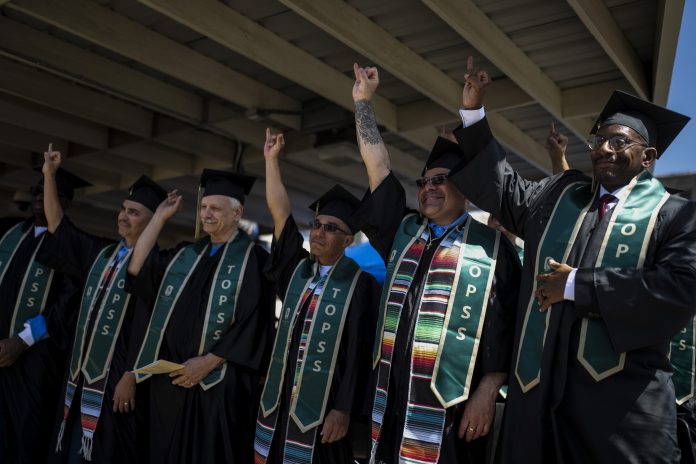REPRESA, CALIFORNIA (AP) — The graduates lined up, brushing off their gowns and adjusting class- mates’ tassels and stoles. As the graduation march played, the 85 men appeared to hoots and cheers from their families. They marched to the stage – one surrounded by barbed wire fence and constructed by fellow prisoners.
For these were no ordinary graduates. Their black commencement garb almost hid their aqua and navy- blue prison uniforms as they received college degrees, high school diplomas, and vocational certificates earned while they served time.
Thousands of prisoners throughout the United States get their college degrees behind bars, most of them paid for by the federal Pell Grant program, which offers the neediest un dergraduates tuition aid that they don’t have to repay.
That program is about to expand exponentially next month, giving about 30,000 more students behind bars some $130 million in financial aid per year.
The new rules, which overturn a 1994 ban on Pell Grants for prisoners, begin to address decades of policy during the “tough on crime” 1970s-2000 that brought about mass incarceration and stark racial disparities in the nation’s 1.9 million prison population.
For prisoners who get their college degrees, including those at Folsom State Prison who got grants during an experimental period that started in 2016, it can be the difference between walking free with a life ahead and ending up back behind bars. Finding a job is difficult with a criminal conviction, and a college degree is an advantage former prisoners desperately need.
Gerald Massey, one of 11 Folsom students graduating with a degree from the California State University at Sacramento, has served nine years of a 15-to-life sentence for a drunken driving incident that killed his close friend.
“The last day I talked to him, he was telling me, I should go back to college,” Massey said. “So when I came into prison and saw an opportunity to go to college, I took it.”
Consider this: It costs roughly $106,000 per year to incarcerate one adult in California.
It costs about $20,000 to educate a prisoner with a bachelor’s degree program through the Transforming Outcomes Project at Sacramento State, or TOPSS.
If a prisoner paroles with a degree, never reoffends, gets a job earning a good salary, and pays taxes, then the expansion of prison education shouldn’t be a hard sell, said David Zuckerman, the project’s interim director.
“I would say that return on investment is better than anything I’ve ever invested in,” Zuckerman said.
That doesn’t mean it’s always popular. Using taxpayer money to give college aid to people who’ve broken the law can be controversial. When the Obama administration offered a limited number of Pell Grants to prisoners through executive action in 2015, some prominent Republicans opposed it, arguing in favor of improving the existing federal job training and re-entry programs instead.
The 1990s saw imprisonment rates for Black and Hispanic Americans triple between 1970 and 2000. The rate doubled for white Americans in the same time span.
The ban on Pell Grants for prisoners caused the hundreds of college-in-prison programs that existed in the 1970s and 1980s to go almost entirely extinct by the late nineties.
Congress voted to lift the ban in 2020, and since then, about 200 Pell-eligible college programs in 48 states, Washington D.C. and Puerto Rico have been running, like the one at Folsom. Now, the floodgates will open, allowing any college that wants to utilize Pell Grant funding to serve incarcerated students to apply and, if approved, launch their program.
President Joe Biden has strongly supported giving Pell Grants to prisoners in recent years. It’s a turnaround – the Violent Crime Control and Law Enforcement Act of 1994, championed by the former Delaware senator, was what barred prisoners from getting Pell Grants in the first place. Biden has since said he didn’t agree with that part of the compromise legislation.
The California Department of Corrections and Rehabilitation had 200 students enrolled in bachelor’s degree programs this spring and has partnered with eight universities across the state. The goal, says CDCR press secretary Terri Hardy: Transforming prisoners’ lives through education.
Aside from students dressed in prisoner blues, classes inside Folsom Prison look and feel like any college class. Instructors give incarcerated students the same assignments as the pupils on campus.
The students in the Folsom Prison classes come from many different backgrounds. They are Black, white, Hispanic, young, middle-aged, and senior. Massey, who got his communications degree, is of South Asian heritage.
Born in San Francisco to parents who immigrated to the U.S. from Pakistan, Massey recalls growing up feel- ing like an outsider. Although most people of his back- ground are Muslim, his family members belonged to a small Christian community in Karachi.
In primary school, he was a target for bullies. As a teen, he remembered seeking acceptance from the wrong people. When he completed high school, Massey joined the Air Force.
“After 9/11, I went in and some, …
Thank you for reading Scoop USA article on scoopnewsusa.com. For more on “Thousands more prisoners across the US will get free college paid for by the government“, please subscribe to SCOOP USA Media. Print subscriptions are $75 and online subscriptions (Print, Digital, and VIZION) are $90. (52 weeks / 1 year).


